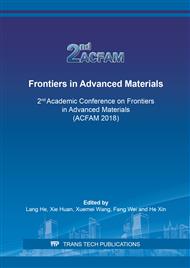[1]
L. Wang, D.P. Wang, W.C. Huang, et al. Fluorescence of cadmium selenide semiconductor quantum dots synthesized by aqueous phase, J Chin Ceram Soc, 2005, 33(10), 1224-1230 (in Chinese).
Google Scholar
[2]
M.J. Yu, W.X. Liu, D.P. Wang, et al. Preparation and characterization of CdSe/ZnS core-shell quantum dots stabilized by thioglycolic acid, J Chin Ceram Soc, 2007, 35(7), 822-827 (in Chinese).
Google Scholar
[3]
W.W. Yu, X.G. Peng. Formation of high-quality CdS and other II-VI semiconductor nanocrystals in noncoordinating solvents: tunable reactivity of monomers, Angew Chem, 2007, 119(15), 2611-2614.
DOI: 10.1002/ange.200790059
Google Scholar
[4]
R.T. Hickey, E. Jedlicka, B.S.S. Pokuri, et al. Morphological consequences of ligand exchange in quantum dot - Polymer solar cells. Org Electron, 2018, 54, 119-125.
DOI: 10.1016/j.orgel.2017.12.018
Google Scholar
[5]
D.M. Kroupa, D.H. Arias, J.L. Blackburn, et al. Control of Energy Flow Dynamics between Tetracene Ligands and PbS Quantum Dots by Size Tuning and Ligand Coverage. Nano Lett, 2018, 18(2), 865.
DOI: 10.1021/acs.nanolett.7b04144
Google Scholar
[6]
P. Shao, H. Wang, Q. Zhang, et al. White light emission from Mn-doped ZnSe d-dots synthesized continuously in microfluidic reactors. Journal of Materials Chemistry, 2011, 21(44):17972-17977.
DOI: 10.1039/c1jm12128f
Google Scholar
[7]
J. Zhang, Q.H. Chen, W.L. Zhang, et al. Microwave-assisted aqueous synthesis of transition metal ions doped ZnSe: ZnS core: shell quantum dots with tunable white-light emission. Appl Surf Sci, 2015, 351, 655.
DOI: 10.1016/j.apsusc.2015.05.178
Google Scholar
[8]
L. Yang, J.G. Zhu, D.Q. Xiao. Microemulsion-mediated hydrothermal synthesis of ZnSe and Fe-doped ZnSe quantum dots with different luminescence characteristics. RSC Adv, 2012, 2(21), 8179.
DOI: 10.1039/c2ra21401f
Google Scholar
[9]
Z.L. Tang, D.M. Li, J.W. Cheng, et al. Preparation and Fluorescence Properties of Aqueous Soluble Thiourea Modified ZnSe: Cu Quantum Dots Acta Phys-Chim Sin, 2013, 29(3), 653 (in Chinese).
Google Scholar
[10]
N. Murase, M.Y. Gao. Preparation and photoluminescence of water-dispersible ZnSe nanocrystals. Mater Lett, 2004, 58(30), 3898.
DOI: 10.1016/j.matlet.2004.03.055
Google Scholar
[11]
G. Xue, W. Chao, N. Lu, et al. Aqueous synthesis of Cu-doped ZnSe quantum dots. J Lumin, 2011, 131(7): 1300-1304.
DOI: 10.1016/j.jlumin.2011.03.012
Google Scholar
[12]
Z.T. Deng, F.L. Lie, S.Y. Shen, et al. Water-Based Route to Ligand-Selective Synthesis of ZnSe and Cd-Doped ZnSe Quantum Dots with Tunable Ultraviolet A to Blue Photoluminescence. Langmuir, 2009, 25(1): 434-442.
DOI: 10.1021/la802294e
Google Scholar
[13]
C.L. Wang, S.J. Zhou, S.H. Xu, et al. Discrimiintrinsic detection of bivalent Cu by dual-emission ZnSe quantum dot fluorescence sensing via ratiometric fluorescence measurements. Nanotechnology, 2014, 25(37): 375602.
DOI: 10.1088/0957-4484/25/37/375602
Google Scholar
[14]
H.Y. Qin, W.P. Jian, Y.N. Zhang, et al. A simple and novel route for the synthesis of water-soluble ZnSe quantum dots using the Nano-Se as the reaction intermediate. Mater Lett, 2012, 67(1): 28-31.
DOI: 10.1016/j.matlet.2011.09.033
Google Scholar
[15]
D. Zhao, J.T. Li, F. Gao, et al. Facile synthesis and characterization of highly luminescent UV-blue-emitting ZnSe: ZnS quantum dots via a one-step hydrothermal method. RSC Adv, 2014, 4(87): 47005-47011.
DOI: 10.1039/c4ra06077f
Google Scholar
[16]
L. Huang, H.Y. Han. One-step synthesis of water-soluble ZnSe quantum dots via microwave irradiation. Mater Lett, 2010, 64(9): 1099-1101.
DOI: 10.1016/j.matlet.2010.02.026
Google Scholar
[17]
Z. Fang, Y. Li, H. Zhang, et al. Facile Synthesis of Highly Luminescent UV-Blue-Emitting ZnSe: ZnS Core: Shell Nanocrystals in Aqueous Media. J Phys Chem C, 2009, 113(32):14145-14150.
DOI: 10.1021/jp903806b
Google Scholar
[18]
V. Lesnyak, A. Dubavik, A. Plotnikov, et al. One-step aqueous synthesis of blue-emitting glutathione-capped ZnSe1−xTex alloyed nanocrystals. Chem Commun, 2010, 46(6): 886-888.
DOI: 10.1039/b919986a
Google Scholar
[19]
Y.G. Zheng, Z.C. Yang, J.Y. Ying. Aqueous Synthesis of Glutathione-Capped ZnSe and Zn1–xCdxSe Alloyed Quantum Dots. Adv Mater, 2007, 19(11): 1475-1479.
DOI: 10.1002/adma.200601939
Google Scholar
[20]
L. Lai, S.Y. Sheng, P. Mei, et al. Hydrothermal synthesis for high-quality glutathione-capped CdxZn1-xSe and CdxZn1-xSe: ZnS alloyed quantum dots and its application in Hg(II) sensing. Luminescence, 2017, 32(2): 231-239.
DOI: 10.1002/bio.3174
Google Scholar
[21]
Y. Liu, Q.H. Shen, D.D. Yu, et al. A facile and green preparation of high-quality CdTe semiconductor nanocrystals at room temperature. Nanotechnology, 2008, 19(24): 245601-245607.
DOI: 10.1088/0957-4484/19/24/245601
Google Scholar
[22]
D. Zhou, J.S. Han, Y. Liu, et al. Nucleation of Aqueous Semiconductor Nanocrystals: A Neglected Factor for Determining the Photoluminescence. J Phys Chem C, 2010, 114(51):22487-22492.
DOI: 10.1021/jp108708n
Google Scholar
[23]
J.S. Han, X.T. Luo, D. Zhou, et al. Growth Kinetics of Aqueous CdTe Nanocrystals in the Presence of Simple Amines. J Phys Chem C, 2010, 114(14):6418-6425.
DOI: 10.1021/jp100501a
Google Scholar
[24]
Z. Xu, D.M. Li, Y.L. Yao, et al. Luminescent Properties of CdTe quantum dots Synthesized by Modifying Thiourea. Acta Phys-Chim Sin(in Chinese), 2009, 25(6): 1201-1206.
Google Scholar
[25]
R.G. Xie, Z. Li, X.G. Peng. Nucleation Kinetics vs Chemical Kinetics in the Initial Formation of Semiconductor Nanocrystals. J Am Chem Soc, 2009, 131(42): 15457-15466.
DOI: 10.1021/ja9063102
Google Scholar
[26]
X.G. Peng, J. Wickham, A.P. Alivisatos. Kinetics of II-VI and III-V Colloidal Semiconductor Nanocrystal Growth: Focusing, of Size Distributions. J Am Chem Soc, 1998, 120(21): 5343-5344.
DOI: 10.1021/ja9805425
Google Scholar
[27]
S. Xiong, S.H. Huang, A.W. Tang, et al. Synthesis and luminescence properties of water-dispersible ZnSe nanocrystals. Mater Lett, 2007, 61(29): 5091-5094.
DOI: 10.1016/j.matlet.2007.04.014
Google Scholar


